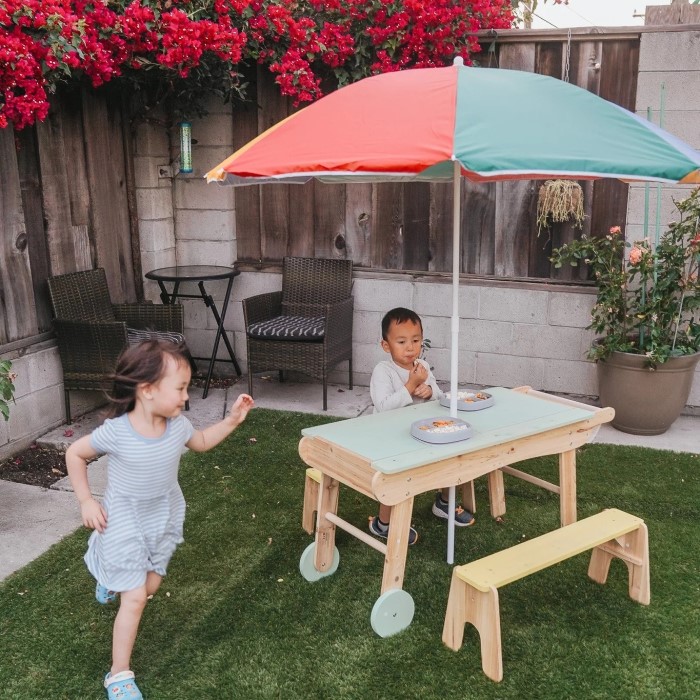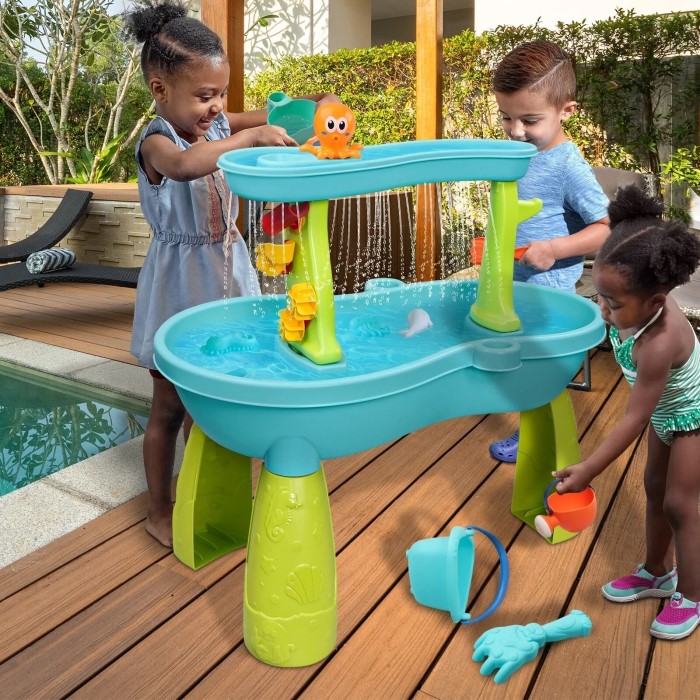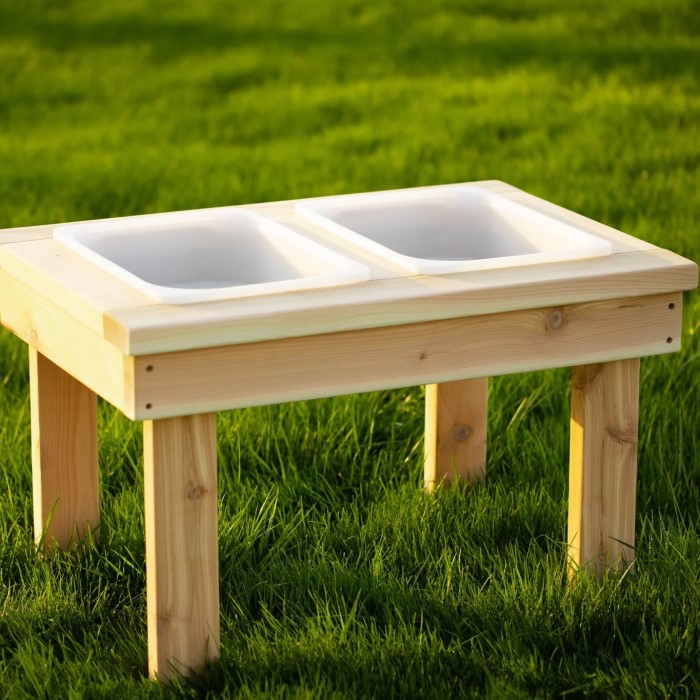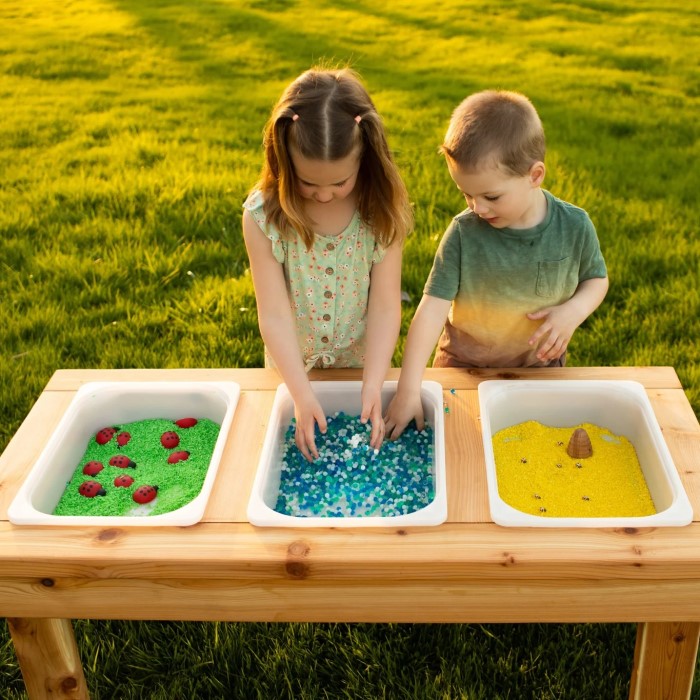What is an Outdoor Sensory Table?
An outdoor sensory table is a play station designed for sensory exploration in open spaces. It often features a sturdy table with compartments for materials like water, sand, or natural items. The purpose is to engage children in hands-on activities that stimulate their senses, creativity, and curiosity. By taking sensory play outdoors, children connect with nature while benefiting from physical exercise and fresh air.
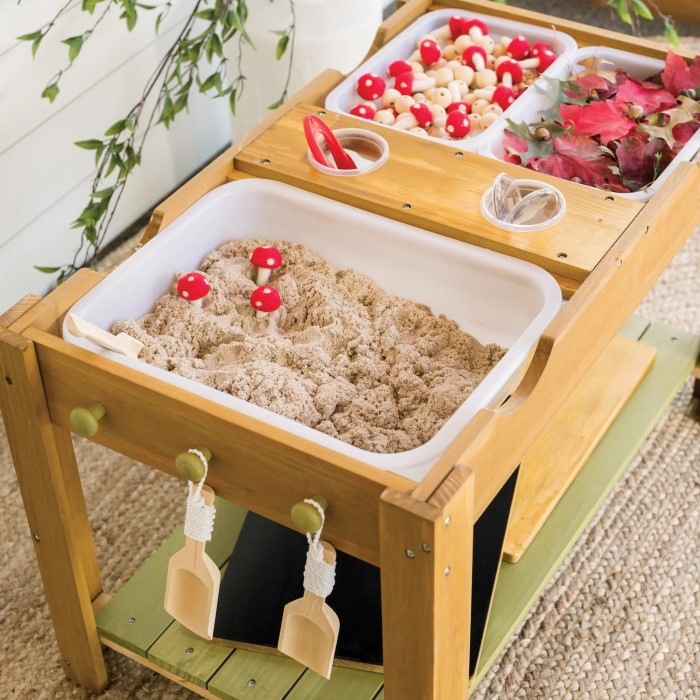
Benefits of Sensory Play for Children
Sensory play supports cognitive, emotional, and physical development in children. It encourages problem-solving by engaging multiple senses simultaneously, such as touch, sight, and hearing. Fine motor skills improve as kids scoop, pour, and manipulate objects. Sensory activities also calm emotions, reducing anxiety and frustration. Lastly, sensory play promotes creativity by allowing children to explore textures, shapes, and materials in non-structured ways.
Why Take Sensory Play Outdoors?
Outdoor sensory play offers unique benefits compared to indoor setups. Fresh air and natural light enhance mood and energy levels. Nature provides additional sensory experiences, from the scent of flowers to the feel of grass underfoot. Outdoor environments allow for larger-scale projects, such as water play or messy activities that might be tough to manage indoors. Finally, outdoor sensory tables encourage kids to connect with the natural world, fostering appreciation and curiosity for their surroundings.
Essential Features
Outdoor sensory tables must be safe, durable, and functional to withstand daily use. The design should cater to varying age groups and encourage creativity and exploration. Here are key elements to consider.
Materials to Use for Durability and Safety
- Weather-resistant materials: Use plastic, treated wood, or stainless steel to resist rain, sun, and moisture.
- Non-toxic finishes: Ensure paints and varnishes used on the table are safe for children.
- Smooth surfaces: Prevent injury by avoiding sharp edges or splinters.
- Sturdy construction: Choose materials that can hold the weight of sand, water, or other items.
- Easy-to-clean features: Removable compartments or trays help simplify cleaning after messy play.
- Portable designs: Consider lightweight or foldable tables if frequent relocation is needed.
Table Size and Design Considerations
- Height appropriateness: Ensure the table height suits your target age group for easy access.
- Spacious compartments: Include multiple compartments for various sensory materials.
- Mobility options: Add detachable or rolling legs for versatile placement and storage.
- Weather covers: Use lids or waterproof covers to protect contents when not in use.
- Interactive elements: Incorporate features like pour spouts or textured surfaces for engaging play.
- Safety enhancements: Install rounded corners and anti-slip pads for added security.
By combining durable materials and thoughtful designs, you can create an outdoor sensory table that is safe, reliable, and versatile.
Creative DIY Outdoor Sensory Table Ideas
Designing your DIY outdoor sensory table can bring fun and engagement for children. Personalizing the table allows incorporation of various materials that cater to specific interests. Here are some creative ideas to consider:
Water-Themed Sensory Table Setups
- Floating and Sinking Activities: Fill the table with water and provide toys to test buoyancy.
- Mini Waterfalls: Add a small pump or tubes for flowing water experiments.
- Ice and Color Exploration: Use colorful ice cubes for sensory and temperature play.
- Bubble Play: Include bubble solution and wands for exciting textures and visual experiences.
Water-themed setups encourage children to explore temperature, motion, and properties of liquids.
Sand and Soil Play Activities
- Buried Treasures: Hide small objects under sand for kids to dig out.
- Construction Play: Provide toy trucks and tools to build mountains or roads.
- Planting and Gardening: Mix soil with seeds for kids to learn about plant life.
- Texture Exploration: Add both coarse and fine sand to compare textures.
Sand and soil activities foster tactile exploration and hands-on creativity.
Natural Elements: Rocks, Leaves, and Sticks
- Rock Sorting: Offer various rock shapes and colors for sorting games.
- Leaf Printing: Use leaves with paint for creative patterns.
- Stick Building: Encourage kids to use sticks to build small structures.
- Nature Art: Combine rocks, leaves, and flowers for crafting activities.
Incorporating natural elements promotes curiosity about the environment.
Seasonal Themes for Sensory Play
- Autumn Leaves and Pinecones: Add dry leaves and pinecones for a fall-themed setup.
- Winter Snow Play: Use artificial snow or crushed ice for frosty fun.
- Spring Flowers and Seeds: Encourage planting activities with spring-themed sensory materials.
- Summer Beach Setup: Include sand, seashells, and water for a beach vibe.
Seasonal themes keep sensory play fresh and exciting while aligning with nature’s cycles.
With these ideas, your outdoor sensory table can become a dynamic and educational play space.
Sensory Table Accessories and Tools
Enhancing your outdoor sensory table with accessories and tools can amplify children’s engagement. Carefully chosen items encourage creativity, problem-solving, and even educational exploration. Below are essential tools designed to maximize sensory play fun.
Scoops, Cups, and Funnels
- Scoops and Shovels: Encourage digging through sand, soil, or water for tactile engagement.
- Measuring Cups: Teach basic math by filling and measuring different-sized cups.
- Funnels: Help children explore flow and movement by pouring liquids or small objects.
- Buckets: Provide depth for water and soil activities while enhancing carrying and filling skills.
- Strainers: Let kids separate objects, boosting fine motor and sorting abilities.
These tools add versatility and support cognitive growth during sensory play.
Adding Colors and Textures
- Colored Sand: Offer multiple hues for mixing, creating patterns, or sorting.
- Colored Water: Use kid-safe dyes to explore blending and color transformations.
- Textured Mats or Objects: Include items like bubble wrap or textured stones for sensory stimuli.
- Foam or Shaving Cream: Add soft, squishy textures to enhance tactile exploration.
- Fabric Scraps: Offer different materials such as velvet, denim, or mesh to compare textures.
Bright colors and varied textures make the table visually appealing and stimulating for creative play.
Incorporating Educational Elements
- Alphabet Blocks: Teach spelling by forming words while engaging in sensory activities.
- Counting Beads: Introduce basic math by counting or sorting colorful beads.
- Shapes and Patterns: Add stencils to teach geometric concepts and pattern creation.
- Magnifying Glasses: Encourage close observation of natural elements like leaves or pebbles.
- Simple Science Experiments: Include tools for sinking, floating, or mixing to explore basic physics and chemistry.
Educational accessories seamlessly combine fun and learning to help children develop essential skills.
Maintenance and Safety Tips
Proper maintenance and safety practices ensure your outdoor sensory table remains enjoyable and secure for kids. Regular care and precautions can prolong the table’s life while keeping children safe during play.
Cleaning and Storing Your Sensory Table
- Rinse After Each Use: Clean compartments with water to remove dirt and residue.
- Use Mild Soap: Wash the table with child-safe soap for a thorough cleaning.
- Dry Completely: Ensure all parts are dry to prevent mold and mildew.
- Storage Solutions: Store the table indoors or use a waterproof cover when not in use.
- Inspect for Damage: Check for cracks or splinters before every use and repair promptly.
Cleanliness and proper storage maintain hygiene and durability of your sensory table.
Managing Allergies and Sensitivities
- Choose Safe Materials: Avoid allergens like nut shells or scented items.
- Introduce Gradually: Test materials like sand or soil with kids to ensure no reactions.
- Label Items: Clearly label compartments to help manage sensitivities.
- Use Sealable Bags: Store allergen-free materials separately to avoid contamination.
- Communicate With Parents: Discuss any allergies before introducing new items during group activities.
These measures reduce the risk of reactions and provide a safe play experience for all children.
Outdoor Safety Considerations for Kids
- Supervise Play: Always monitor children to prevent misuse or accidents.
- Create Shaded Areas: Protect kids from harmful UV rays during playtime.
- Avoid Small Objects: Prevent choking by using age-appropriate materials.
- Secure the Table: Stabilize the table to avoid tipping over during play.
- Teach Proper Use: Show kids how to handle tools and materials safely.
By following these safety tips, outdoor sensory play becomes both fun and secure for kids.
Ways to Encourage Engagement and Learning
Creating meaningful activities helps children connect with sensory play and boosts their learning. Use simple techniques to promote curiosity, creativity, and interaction. Below are effective ways to enhance engagement.
Incorporating Storytelling into Play
- Create Adventures: Design stories about pirates, explorers, or scientists to match sensory materials.
- Use Character Props: Include figures like animals or heroes to bring stories to life.
- Narrate Actions: Guide kids through play by describing what they are doing in the story.
- Encourage Role Play: Let children act as the characters, fostering imagination and confidence.
- Develop Sequencing Skills: Help kids understand cause and effect by connecting events within the story.
Storytelling adds depth to sensory activities, enabling children to learn through meaningful play.
Guided Questions to Stimulate Creativity
- Ask About Feelings: “What does this sand feel like?” helps kids describe textures.
- Pose Challenges: “Can you build a tower with sticks?” encourages problem-solving.
- Explore Differences: “How does water move through the funnel?” boosts critical thinking.
- Mix Materials: “What happens when we add colored water to the sand?” sparks curiosity.
- Focus on Observation: “What colors or shapes do you see?” develops attention to details.
Guided questions inspire children to think and explore ideas during sensory play.
Group Activities for Social Interaction
- Team Tasks: Assign kids to work together to build or sort materials.
- Sharing Games: Encourage kids to exchange tools and materials during play.
- Create Obstacle Courses: Develop activities where children work together to overcome challenges.
- Story Collaboration: Let kids create joint stories using sensory items.
- Nature Exploration: Bring groups outdoors to find rocks, leaves, or sticks for shared activities.
Group activities build teamwork skills while enhancing social connections during sensory exploration.
Additional Resources for Sensory Play Inspiration
Finding inspiration for sensory table activities can enhance creativity and educational value. Explore resources that offer new ideas, techniques, and community support.
Books and Online Guides
Sensory Playbooks
- Books on Outdoor Sensory Play: Seek out books dedicated specifically to outdoor sensory play. These playbooks often provide insights into various activities and creative setups that can enhance children’s learning experiences. They may include recipes for sensory materials, ideas for themed play, and guidelines for safe play.
- Benefits of Using Playbooks: Sensory playbooks can serve as valuable resources for parents and educators. They often contain illustrations and step-by-step instructions, making them easy to understand and follow. The creative setups suggested in these books aim to foster exploration, curiosity, and imaginative play in children.
Educational Websites
- DIY Guides for Sensory Tables: Utilize educational websites that offer comprehensive DIY guides and tips for designing sensory tables. These sites often provide suggestions for materials, setup ideas, and sensory bins tailored for outdoor environments.
- Accessibility of Resources: Many educational websites feature user-friendly interfaces that allow easy navigation through different project ideas. Additionally, they may provide user reviews or ratings to help you determine the effectiveness of specific setups based on other parents’ experiences.
Video Tutorials
- Step-by-Step Instructions: Watching video tutorials can greatly enhance your ability to build and utilize sensory tables effectively. These videos typically offer visual demonstrations of the entire process, from selecting materials to setting up the table for use.
- Learning Through Observation: Being able to see the assembly process in real-time allows for better comprehension of techniques. Many video tutorials also include tips from experienced educators or parents about common pitfalls to avoid or creative variations to try.
Printable Activities
- Downloadable Activity Sheets: Printable sensory play activity sheets are an excellent resource for implementing sensory activities easily. Many websites offer free or low-cost downloads that you can print at home.
- Ease of Implementation: Having these activity sheets simplifies planning for sensory play. They often include step-by-step instructions and necessary materials, allowing you to set up engaging activities without needing extensive preparation time.
Parenting Blogs
- Child Development Insights: Read parenting blogs that focus on child development for tailored sensory table ideas. These blogs typically share personal experiences and practical advice, making them relatable and informative.
- Finding Customizable Ideas: Many parenting bloggers offer unique perspectives on sensory play, providing insights into what works best for different age groups or developmental stages. These ideas can be easily customized to suit your child’s interests and needs, ensuring a more engaging play experience.
Books and online guides provide visual and step-by-step instructions for inspired playtime.
Community Ideas and Workshops
- Local Workshops: Attend hands-on sessions for building and customizing sensory tables.
- Social Media Groups: Join online groups to exchange sensory play tips and creations.
- School Events: Participate in school programs that showcase sensory activities and designs.
- Community Centers: Collaborate with others to share ideas and materials for sensory tables.
- Parent Networks: Connect with other parents to gather ideas and feedback on sensory play setups.
Engaging with communities and workshops sparks innovative ideas and creates collaborative opportunities.
Conclusion: Transforming Your Outdoor Space
In conclusion, outdoor sensory tables are an incredible addition to any backyard, offering endless opportunities for fun, creativity, and learning. By filling your sensory table with various materials and incorporating fun themes, you’ll create engaging experiences that promote sensory exploration. Remember to prioritize safety and social interaction as you design activities for your sensory table. Outdoor sensory tables not only entertain kids but also provide significant developmental benefits. As you gather your supplies and set up your outdoor sensory table, keep the keywords “outdoor sensory table” in mind to enhance your planning. Happy exploring!
